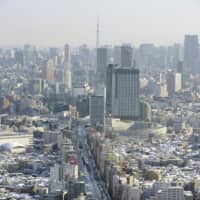Weather observatories are shifting toward providing snow forecasts for shorter time frames, hoping to better accommodate sudden weather changes and prevent disasters and traffic disruptions.
The observatories have traditionally forecasted snow for the next 24 hours, but many have shifted to 12 hours and some even to six hours as snow has been causing delays in train services and stranding vehicles on roads even in the early stages of accumulation, according to the Meteorological Agency.
The observatories issue heavy snow warnings based on the forecasts for each municipality, and shortening the forecast span means the warnings would be based on more accurate information than before.
The 12-hour forecast was introduced in Hokkaido in 1995 and has since spread to Tokyo and 31 prefectures, the agency said.
Among the areas that have adopted the system are some that are not accustomed to receiving much snow. They include those on the Pacific coast, such as Shizuoka and Mie prefectures, which often only get snow for half a day due to a low pressure system that develops during winter and spring and travels eastward along Japan's southern coasts.
Meanwhile, many areas that receive heavy snowfalls have adopted the six-hour forecast.
A part of the Ishikari region, including Sapporo, issues heavy snow warnings if 30 cm is expected in the next six hours or 40 cm in next 12 hours, while Niigata issues such a warning if 30 cm of snowfall is forecasted in the next six hours.
"Snow-caused road closures have a big social impact. We are considering what would be effective standards in issuing warnings and advisories," said an agency official.
The standards, including the time frame and amount of snowfall, are set for each municipality, excluding those in Okinawa, which has a subtropical climate, and are subject to reviews if necessary.



